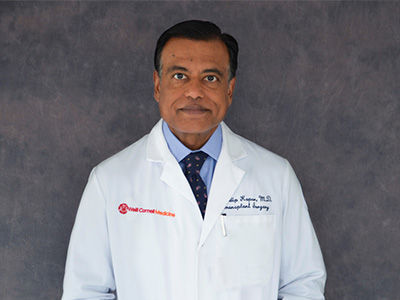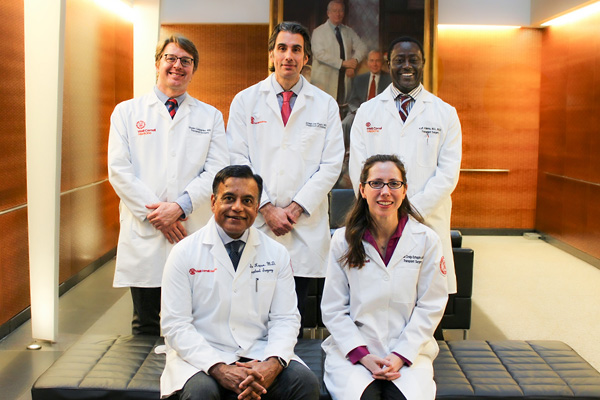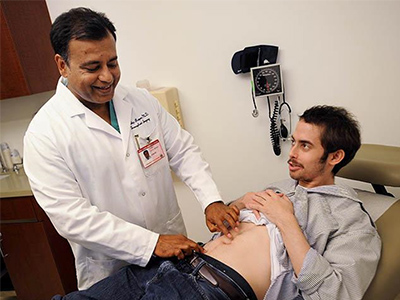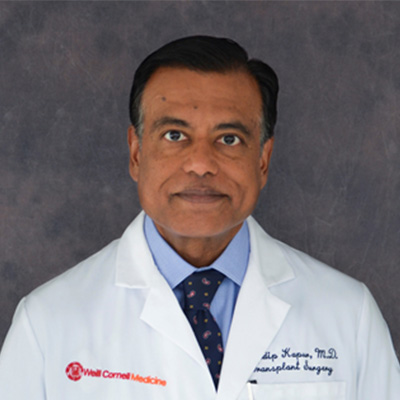Dr. Sandip Kapur, MD, Chief of Transplant Surgery and Director of the Kidney and Pancreas Transplant Programs
Over nearly three decades of pioneering transplant techniques and clinical achievements, Sandip Kapur, MD, Chief of Transplant Surgery and Director of the Kidney and Pancreas Transplant Programs at NewYork-Presbyterian/
Kidney Failure Reaching Epidemic Proportions in the US
“Kidney failure has reached epidemic proportions in the US, and the demand for kidney transplant is higher than ever,” says Dr. Kapur, who heads the oldest kidney transplantation program in New York State and one of the highest volume living donor kidney transplant programs in the country.
We know from over 50 years of transplant experience that living donor kidney transplant enables many of our patients to receive a transplant before needing dialysis, and they receive a better quality, longer-lasting kidney, which improves outcomes and quality of life.
In 2019, the NewYork-Presbyterian/
Maximizing Opportunities for Kidney Transpantation
At NewYork-Presbyterian/
NewYork-Presbyterian/
“Our program’s mission is to maximize opportunities for transplantation, whether it’s pushing the limits on the deceased donor side, or developing new avenues for living donor transplantation, or being willing to transplant patients that maybe wouldn’t be considered at other institutions because of unique or difficult aspects,” says Dr. Kapur. “We offer hope for any patient that comes in to see us. Essentially, if I can’t help you, it’s because there’s no other option left.”
Surmounting the Most Challenging Cases in Kidney Transplantation
Helping as many people as possible compelled Dr. Kapur to choose a career in kidney transplant. “I went into multi-organ transplant and kidney transplant in particular, because I know every time I perform a kidney transplant, there’s a better than 99% chance I’ll have an incredibly positive effect on the person I’m operating on.”
Dr. Kapur’s training in multi-organ transplantation exposed him to a wide range of complex patients with unique anatomies, which he says provided a broad base of experience and emboldened him to push the limits of what he thought was possible in kidney transplantation.
“I remember one patient in particular had a very complex clotting condition with limited sites to place a new vascularized organ,” recalls Dr. Kapur. “This patient endured kidney disease for such a long time, which in some ways, made her stronger. She had this inner strength that motivated me to do my utmost to make sure she was transplanted, and she went home with a completely normal functioning kidney.”
“In another case, I transplanted a patient with polycystic kidney disease,” he continues. Normally, someone with this condition would need a staged transplant, meaning at least two operations. I am among a very small handful of surgeons in the country that offers a single stage operation in which I remove the enlarged kidneys and place a new transplant at the same time. In this way, the patient avoids two or more major operations and avoids any time on dialysis. This patient has done incredibly well and is very grateful, and I have now performed approximately 100 of these procedures. I knew with my broad training and exposure that I could accomplish almost anything in transplant, and is a good reminder that, as a surgeon, you can’t let preconceived notions or fear put a wall between you and what you can do for patients in these extraordinary circumstances.”
Creating More Pathways to Living Donation
Under Dr. Kapur’s innovative leadership, the Weill Cornell kidney transplant program became one of the largest in the country, and is now the top ranked program in New York for living donor kidney transplantation. “Live donation offers the best outcomes we can provide in kidney transplant,” says Dr. Kapur. “Compared to deceased donation, patients with a willing living donor have more pathways to enable living donation to happen.”
The most efficient pathway is participation in the National Kidney Registry (NKR), which Dr. Kapur helped to establish at NewYork-Presbyterian/
Dr. Sandip Kapur with Kidney Transplant Patient
With the NKR, Dr. Kapur spearheaded Kidney Paired Donation, an innovative program that allows two patients who each have incompatible donors to exchange or swap donors with each other in order to attain a better match. Dr. Kapur also led the first NKR living donor kidney transplant surgery chains to maximize the number of patients who receive a living donor kidney while ensuring that all involved recipients receive a donor kidney that is the best possible match for them. This ‘chain of love,’ as Dr. Kapur calls it, has revolutionized kidney transplant.
“Historically, live kidney donation was driven by the emotional connection between recipient and donor, who was either a close relative or a friend,” says Dr. Kapur. “However, among people who came to us, 30% of the time the pair was incompatible. That eventually led to the donor exchange process, in which donors make an anonymous, or altruistic, non-directed living kidney donation, which then indirectly benefits their loved ones. With advanced compatibility testing, we can prioritize the best available match that so people can hold on to their kidneys longer, which optimizes their outcomes.”
The Cultural Shift From Emotional to Altruistic Kidney Donation
“We are now seeing the beginnings of a cultural shift in the way we are approaching living kidney donation,” says Dr. Kapur. “More people are understanding that kidney exchange benefits not only incompatible pairs, but compatible pairs, too. As more transplant centers register both their incompatible and compatible pairs with the NKR, the probability of finding suitable matches and performing successful transplants improves exponentially.”
Dr. Kapur is driving the cultural shift from emotional to altruistic kidney donation through meaningful discussions with people to build awareness and trust. “The concept of altruistic donation is relatively new, and many people who are considering donation don’t know the real story unless it’s explained to them,” says Dr. Kapur. “I try to hit all the key points so people can have that ‘A-Ha!’ moment. I tell them they’re not just helping the person they came in with, they can be the key to unlock the door that can allow five, ten, or fifteen people to get a kidney. Once they understand this, I can bridge that emotional divide.”
“In the field of living donation, we are dealing with patients who have end stage kidney disease, so in many cases they’ve lost control of their lives from being on dialysis, and they are scared,” continues Dr. Kapur. “First and foremost, I try to humanize the situation and make them realize that I’m just a person, and from there I try to establish trust, because unless there is trust, people are not going to listen to me, they are going to be driven by their fears rather than the reality of the situation.”
“If you look at the work conducted here, it is just amazing,” says Dr. Kapur. “Over the course of our participation with NKR, we have transplanted the vast majority of our incompatible pairs, which is an enormous success.”
Our efforts are now focused on enhancing the quality of the matches and fairly new developments in compatibility matching. We know that even when patients come forward with a compatible donor, the newly available enhanced testing may offer them an opportunity for an even better matched kidney through paired donation.”
My goal is to shepherd the cultural shift toward living donor transplant to enhance the best possible match that will maximize the longevity of the grafts, and improve outcomes,” says Dr. Kapur.
“When I started in this field and developed my niche in living donation, I realized early on that what I so appreciated about living donation is that it requires someone to think beyond themselves, and do something that no one else would. That whole understanding has propelled me to work even harder to work for people who feel like they don’t have any other opportunities.”







